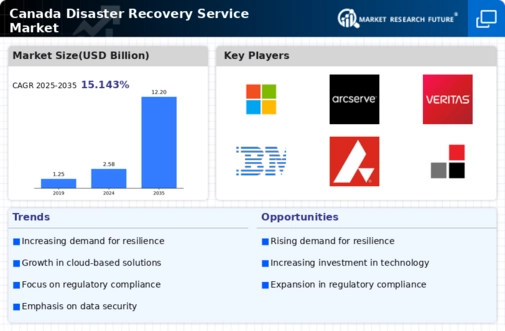Increased Cybersecurity Threats
The surge in cybersecurity threats is significantly impacting the disaster recovery-service market. Canadian organizations are facing an escalating number of cyberattacks, which can lead to data breaches and operational disruptions. This reality is driving businesses to invest in disaster recovery services that include robust cybersecurity measures. A report from the Canadian Centre for Cyber Security indicates that cyber incidents have increased by over 50% in recent years, underscoring the urgent need for effective recovery strategies. As organizations recognize the importance of safeguarding their data and ensuring business continuity, the disaster recovery-service market is likely to see substantial growth, with a focus on integrated recovery solutions that address both physical and cyber threats.
Regulatory Compliance Requirements
Regulatory compliance is increasingly influencing the disaster recovery-service market. In Canada, various industries are subject to stringent regulations that mandate the establishment of disaster recovery plans. For instance, financial institutions must adhere to guidelines set by the Office of the Superintendent of Financial Institutions (OSFI), which emphasizes the need for robust recovery strategies. This regulatory landscape compels organizations to invest in disaster recovery services to meet compliance standards and avoid potential penalties. As a result, the disaster recovery-service market is expected to experience growth, with businesses prioritizing compliance-driven solutions to safeguard their operations and maintain regulatory adherence.
Rising Frequency of Natural Disasters
The rising frequency of natural disasters in Canada is a critical driver for the disaster recovery-service market. Events such as floods, wildfires, and severe storms have become more prevalent, prompting organizations to reassess their preparedness and recovery strategies. This trend is likely to lead to increased demand for disaster recovery services as businesses seek to mitigate the impact of such events on their operations. According to Environment and Climate Change Canada, the number of extreme weather events has increased by approximately 30% over the past decade. Consequently, the disaster recovery-service market is expected to expand as companies prioritize resilience and invest in comprehensive recovery solutions.
Growing Awareness of Business Continuity
The increasing recognition of the importance of business continuity planning is a key driver in the disaster recovery-service market. Organizations in Canada are becoming more aware of the potential risks posed by natural disasters, cyber threats, and other disruptions. This awareness is prompting businesses to invest in comprehensive disaster recovery strategies to ensure operational resilience. According to recent data, approximately 70% of Canadian companies have implemented some form of business continuity plan, reflecting a growing trend towards proactive risk management. The disaster recovery-service market is likely to benefit from this shift, as companies seek specialized services to enhance their recovery capabilities and minimize downtime during crises.
Technological Advancements in Recovery Solutions
Technological advancements are reshaping the disaster recovery-service market, particularly in Canada. Innovations such as cloud computing, artificial intelligence, and automation are enhancing the efficiency and effectiveness of recovery solutions. For instance, cloud-based disaster recovery services allow organizations to quickly restore data and applications, reducing recovery time objectives (RTOs) significantly. The market is projected to grow as businesses increasingly adopt these advanced technologies to streamline their recovery processes. In fact, a recent survey indicated that over 60% of Canadian organizations are considering cloud-based solutions as part of their disaster recovery strategies, highlighting the potential for growth in this segment of the market.























Leave a Comment